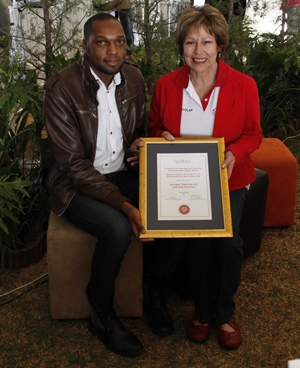
Dr Elize Smuts (right) proudly displaying the UFS Vice-Chancellor’s Team Award. Equally ecstatic, is Qwaqwa Campus’s CTL Manager, Fred Mudavanhu.
Photo: Thabo Kessah
|
Action research to improve classroom practice and student success rates, recently received a boost when the Qwaqwa Campus’s Teaching and Learning (TL) Champions were honoured with the prestigious UFS Vice-Chancellor’s Team Award. The award was in recognition of the team’s efforts to enhance professional development and was accompanied by a R50 000 prize that will be utilised to further encourage and develop a scholarly culture on the Qwaqwa Campus.
“An active learning community has developed over the past four years, which led to the creation of a scholarly forum for sharing problems, experiences and new knowledge”, revealed Dr Elize Smuts, who has been the pillar of strength in the development of TL Champs.
“This”, Dr Smuts said, “has continuously motivated the group to persevere in challenging and often under-resourced circumstances.”
“Over a four-year period, 44 projects were undertaken, many with great success. Thirteen scholars participated in a pilot of CLASSE (Classroom Assessment of Student Engagement) in 2013. This survey, contextualised by staff from the Centre for Teaching and Learning, was a first in South Africa,” said Dr Smuts.
“The team undertook extensive literature reviews and attended numerous workshops on principles and practices of good teaching, research and writing. The two summarising booklets they prepared from two publications (How Learning Works: 7 Research-based Principles for Smart Teaching and Student Engagement Techniques) in 2013, will serve as guides and inspiration for the larger academic community of the UFS for many years.”
Since the formation of this team, TL scholars have presented 25 papers at 12 national and two international conferences.
“Taking into consideration that it is not easy to get an abstract accepted for presentation, these are impressive achievements,” Dr Smuts said.
“Some of the immediate results of scholars engaged in this project, include improved student success rates averaging 20% compared to only 8% improvement by academics who are not part of the project.”
“In 2013, one TL scholar reported student success rates that increased by 29%; another reported 80% on average; and another reported an increase from 65% to 95% in a class bigger than previous years.”
In congratulating the team, Centre for Teaching and Learning’s (CTL) Prof Annette Wilkinson said that she was very proud of the team.
“The team’s dedication and growth in scholarly practice – amidst challenging circumstances – are in my mind, the outstanding features of the project. I am very proud of the entire team”, said Prof Wilkinson.
The two presentations at international conferences were delivered by Ms Lea Koenig at the 32nd Annual Conference on the First-Year-Experience in Orlando, Florida and by Dr Elize Smuts in North Carolina. Both of these were presented in 2013.